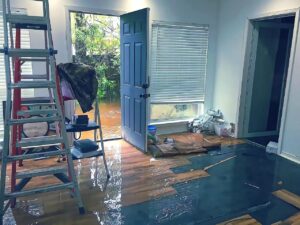The aftermath of a flood can leave you with a home full of water-damaged furniture, appliances, submerged basements, and soaked utility outlets. The subsequent clean-up can be challenging and sometimes heartbreaking. However, one of the most menacing problems from floodwater typically shows up the next day or a few days later—in the form of mold and mildew.
This disgusting growth carries the dual threat of negatively impacting your home’s value and your health and well-being. Discovering the first signs of mold and mildew is an indication that you have a fight on your hands. But it’s a fight you can win or even avoid if you are aware of your options ahead of time.
What are Mold and Mildew?
People often use the words “mold” and “mildew” interchangeably. However, they define two different things.
Mold describes every species of microscopic fungi that evolve into hyphae, a class of multicellular filaments. During and after a flood, mold feeds on any wet organic material in your home, such as:
On the other hand, mildew is often used to describe mold growth and is actually a type of mold. Characterized by a flat growth pattern, mildew usually thrives on shower walls, windowsills, and other high moisture hosts like damp floors, walls, and ceilings. If you can’t visually spot mold or mildew, you can often smell their robust and musty scent in unventilated areas.
How Do Mold and Mildew Appear in Your Home?
While the phrase is often tossed around, it’s not accurate to say that mold “appears” in your home. The reality is that mold is everywhere because it floats in the air in the form of microscopic spores.
When the mold spores land on wet surfaces, they start to reproduce and form the furry mass you usually recognize as mildew. Humid post-flood conditions provide a fertile breeding ground for mold, with plenty of wet organic material to consume. Although it can take form in many colors, mold is commonly white or black with a bluish hue.
How Does Mold Make You Sick?
Molds become harmful to humans and property after landing on a damp host and beginning to reproduce and grow. In nature, molds play an essential role by decomposing dead organic matter like dying trees and fallen leaves. But mold turns from nature’s helper to a menace and health hazard in your home. Mold releases allergens into the air. When inhaled, these tiny mold spores can cause respiratory symptoms like sneezing, red eyes, dermatitis, and runny noses. Also, mold can produce mycotoxins, potentially toxic substances that can lead to severe illnesses.
However, the most common consequence of mold is an allergic reaction, usually irritating to the skin, nose, throat, lungs, and eyes. Since mold can cause an asthma attack, people with asthma should be extra careful in areas where it could be growing.
Why Mold and Mildew are So Difficult to Clean-Up?
When it comes to clean-up, colonizing mold can be a formidable opponent for several reasons. The main reason is they can remain dormant for many years, until conditions facilitate growth. As a result, mold spores are impossible to get rid of. However, if you remove the moisture and the humid environment, mold spores can’t grow and cause additional damage.
So, after a flood, a prompt and expert clean-up is necessary as soon as it is safe. It usually takes about 24 hours before mold appears and becomes a health threat. As a result, you should immediately remove all cellulose food sources for mold and use a dehumidifier to take as much moisture out of the air as possible.
Who Should Do the Clean-up?
Since a mold infestation poses a long-term health risk in your home, the clean-up process is crucial. You should leave it to a professional service provider like Emrick Services. If your moldy area is smaller than 10 square feet and you aren’t prone to asthma attacks or severe allergic reactions, you may be able to handle the job on your own. But for significant water damage with a large breeding ground for mold, it is best to leave the work to an established and experienced flood restoration company like Emrick Services.
Removing surface mold can help to alleviate health concerns. However, after a flood, mold spores may form in your walls, under your floorboards, or in drywall. Without proper removal, they may lurk there for years, slowly growing and spreading, and putting your health and even the structure of your home at risk.
Emrick’s well-trained professionals have the experience necessary to eliminate the factors responsible for mold infestation at every level. They mitigate water damage, remove mold, dispose of biohazards, and conduct structural inspections.
Benefiting from Confronting Mold and Mildew After a Flood
After your home experiences flooding, you’ll likely be more worried about finding a place to stay or saving some of your important and irreplaceable belongings than you are about mold and mildew. But while you’re taking care of the aftermath of the water damage, spores may be making their way into your walls, floors, and the air in your home, putting your health and the structural integrity of your home at risk.
Emrick Services can help. Call your insurance agent and ask to work with us on your water damage restoration and mold removal. We’ll help protect your home from additional damage, clean up the mess, and help your family breathe easy.








